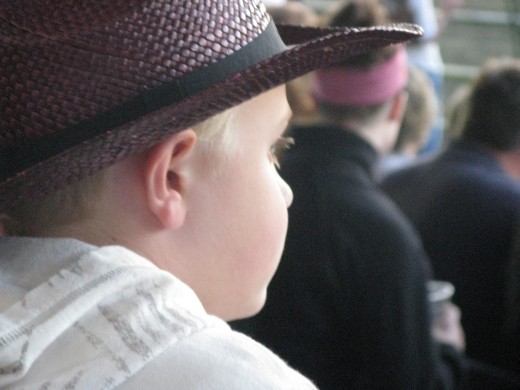Children and Shyness

Downcast eyes and lowered lashes protected me from the gleaming smiles and direct eyes of my mother’s friends. The linoleum floor was interesting enough to look at, and my ears could take in what was happening around me. As long as their conversation flowed without pause, I was safe.
“And how are you?” directed at me.
Perhaps if I didn’t acknowledge the question, I wouldn’t have to speak. I felt a firm hand on my back from my mother and my own hands instantly covered my face, leaving only two small openings between my pinkies where I could peer out from behind the bars of my cage.
I was grossly shy from five or six years old to the ripe old age of twelve-ish. I was a captive to my own personality, a captive to self-consciousness, a captive to my personal comfort, but I was incapable of making myself personable, presentable, or even comfortable.
Overcoming shyness was not a priority in my life until my mother pointed out one day that my shyness was just an excuse for selfishness. In trying so hard to make myself comfortable by staying within my own comfort zone of silence, I was making everyone else tremendously uncomfortable because I was the cause of an awkward situation. I was making the people around me feel unloved, snubbed, and even despised. Not only that, but I was so concerned about what everyone thought of me and not wanting to show my true person to anyone, that I was missing all opportunity to delve into the needs and desires of the people around me. I could not serve them because I did not know them, and I did not know them because I did not care about them, and I did not care about them because I only thought about myself.
I still look back on that cowering, curled up creature with shame and pity. All around her were people with dreams, hopes, pains, fears, joys, and sorrows, but she was so utterly consumed with herself that there was no life outside the cage of her fingers over her face. She thought her heart was deep enough: a well of ponderous speculations about life and philosophy. There was no need to explore the depths of anyone else’s character. She was all she needed. What could anyone else possibly have to offer her?

Overcoming Shyness in Children
The important thing that my mother did was to not excuse my tendency toward shyness as a beautifully unique facet of my personality. No, she regarded it as a character flaw. When I so rudely ignored and hid from friendly inquirers, she didn't excuse me with "She's just shy," and a smile. Instead she told me that we would have to talk about this later, and then she apologized in front of me for my behavior. Because of this, I knew my shyness was unacceptable and that it was wrong to behave the way I did. Trying to change at that point seemed impossible and terribly intimidating. I hated change of any sort, even if I knew it would a good thing for me.
One thing that my mom tells me was a crucial point in overcoming shyness happened one day when she sent me with a package into the post office. I hated to speak strangers, but cashiers were the worst sort of strangers because they expected me to interact with them. However, I knew putting up a fight wasn't going to get me any leniency. It was either take the package in to the office now, or do it a little later, but after an argument. I took the package in without a protest. My mother was surprised, but was wise enough to not comment on my change of behavior. She was proud of me, as she told me later, because I took that first step to get out of myself and into a world where other people exist.
Another thing that helped me overcome shyness as a child was stepping out of my comfort zone when my parents weren't watching. I would have been terrified if I knew they were observing me being different. I could just imagine them commenting on how I had changed and then speculating on what caused it. That would be much, much worse (for some unexplainable reason) than to brave the postal worker's conversation with me when I handed in a package. Perhaps it was fear of being scrutinized, observed, or in the limelight. A postal worker didn't know I was afraid to talk to her, so I could gird up my courage and speak to her and she would never know I had crossed the line in the sand.
Teaching the Art of Conversation
I did receive direct teaching and reproof for my shyness problem too. My father would reach over and touch my shoulder to straighten it whenever he saw that I was self-consciously curled up into myself. Years later, when I got contact lenses and entered into the whole new world of being able to see people's expressions from across the room, I was able to lift my head and eyes without thinking, because I now wanted to watch and understand the people around me. People's eye and expressions mattered, because eyes revealed thoughts and faces revealed character.
I remember particularly well being in the car one day either on the way to or from a social event, and my mother, who was driving, gave me some practical tools to use to start conversations whenever I was around other people. These are the things she told me:
1. If you are an outsider from the conversations and laughter of the popular circles of people, that's your chance to go find someone else who seems shy, like you, to talk to. Chances are, you're probably not the only one feeling shy in the room, and maybe someone else is feeling left out or cast out and could use someone to be with them. Not talking, necessarily, but sitting there with them, certainly.
2. If someone asks a question, don't give a one-word or condensed answer. Conversation is like a game of tennis. The ball has to keep moving with more ideas and facts and words from each side.
3. Ask questions. Once you can get someone talking about something they love or something they know a lot about, you don't have to fish around for ideas of what to say because they are doing all the talking! Listen well, with appropriate comments and follow-up questions, and the conversation will continue pleasantly for several minutes or more.
4. Always focus on the other person more than yourself. Find ways to complement them, to draw them out, and to develop your friendship or acquaintanceship with them. Bring up subjects that you know they will enjoy talking about, and keep your mind active and alert throughout the conversation so that you can follow the threads of thought to a topic that might be fun, encouraging, or spiritually and intellectually stimulating to both of you.

Parents: Be a Good Example to Shy Children
My parents' mannerisms when they were with other people taught me how to talk and engage. My dad is known for broaching difficult or controversial subjects in a lighthearted and friendly way, and before the stranger even realizes what has happened, the stranger is telling us all about his search for truth and what he doesn't understand about the world. That provides my dad a perfect opportunity to witness and give his own testimony, and the stranger often stays around conversing for several more hours. As a little girl with her eyes level with the countertop at the restaurant, I would listen to my dad start these conversations by making amusing comments or asking questions about their job. Instantly the person on the other side of the counter would become a human being, and I noticed new light in their eyes and a few witty comments from their side of the world as well.
My mother's influence in overcoming my shyness has been greater; perhaps this is because I was with her more hours of the day since she home-schooled me and my siblings, or perhaps it is because she also struggled with shyness and now knows many ways to overcome it. Her advice has been invaluable, and I'm thankful she never excused or allowed me to be so introspective and self-focused that I couldn't carry on a conversation with someone who God created.
Polls show that 95% of grown adults admit to being shy or struggling with shyness occasionally. Theorists say the other 5% is probably not telling the truth. Shyness for adults often happens when there is someone nearby that we admire, look up to, or are trying to impress. Adults are intimidated by the higher status, greater successes, and even the appearance of someone else "having it all together." Thankfully, most adults have learned how to carry on a conversation without their hands over their faces or giving monosyllabic answers. By analyzing their own shyness and the ways they have overcome it, parents can be an excellent resource in helping their children overcome their shyness, as my parents did.
© Jane Grey 2010








